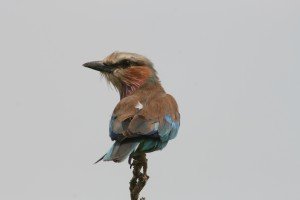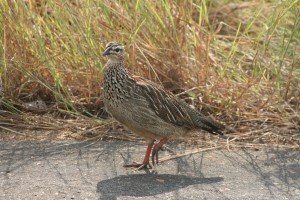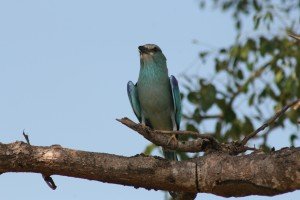Lower Sabie to Letaba 0
Driving from Lower Sabie to Letaba is one of the lengthiest routes (160km) one can hope to fit into a day in Kruger National Park, but the eastern sweetveld plains you travel through are richly rewarding.
This is prime birding country, travelling through the open savanna grasslands between Lower Sabie and Satara, heading into the Olifants rugged veld and then into the Mopane-dominated woodland around Letaba. Several of the roads also flirt with the Lebombo Mountains in the east, all of which adds up to numerous different habitats and a lengthy bird list.
The central grasslands around Satara are known as big-game country – there is plenty of grazing and therefore plenty of predators, whose kills attract the vultures.
And the king of the South African vultures – the Lappetfaced – is best found in this area and mine was duly spotted on the tar road (H1-4) between Satara and Olifants. It was an archetypal sighting as well – attending a kill, looking like the Red Skull with its featherless head and neck and malevolent, massive bill.
The Red Skull
On the other side of Olifants, as the Mopane becomes more and more prevalent, Kori Bustard, another of Kruger’s “Big Five” birds, was spotted and other quintessential grassland birds seen between Lower Sabie and Letaba were Steppe Eagle, Rufousnaped Lark, Pintailed Whydah, White Stork, Wattled Starling (particularly common around Satara), Blackshouldered Kite and Swainson’s Francolin.
It’s also great raptor country and, apart from the vulture, resident Blackshouldered Kite and the migratory Steppe Eagle (in the Mlondozi/Muntshe area), Bateleur, Brown Snake Eagle, Whitebacked Vulture and Wahlberg’s Eagle were also seen.
But there are enough different habitats on the route to throw up all sorts of interesting things, and Jacobin Cuckoo, Carmine Bee-Eaters dashing around like the Red Arrows, Melba Finch (in the mixed woodland of the Trichardt Road heading into the Lebombo), Namaqua Dove, Natal Francolin and Helmeted Guineafowl were all spotted.
Late summer in the central savannas of Kruger Park are a time of feast and even the smaller birds were cashing in: just north of Lower Sabie there were a handful of Crested Francolin on the tar road, gorging themselves on a swarm of mayfly-like insects.
Aquatic habitats along the route further boost the tally; as you leave Lower Sabie you cross the Sabie River and from that causeway Wiretailed Swallow, Greenshank, Common Sandpiper, Pied Kingfisher and Brownthroated Martin were seen.
Temporary pans on the basalt produce Wood Sandpiper, while there was even water in the watercourse at Tshokwane and a Threebanded Plover in attendance.
The Mazithi Dam on the side of the road just north of Tshokwane was full and a Grey Heron was perched on a half-submerged log of dead tree, with a couple of Hippo for company down below.
Turning off east shortly thereafter, one travels along the Trichardt Road (S37), which takes one through highly nutritious grasslands and mixed woodland as it skirts the Lebombo Mountains, eventually coming to the Sweni River and Sweni Hide, where Malachite Kingfisher was spotted.
There is unsurprisingly plenty of game along the route from Lower Sabie to Letaba as well, with 14 species of mammals, including Hippo, Elephant, White Rhino and Buffalo, seen along the way.
Sightings list
Little Swift
Blackeyed Bulbul
Impala
Blue Wildebeest
Wiretailed Swallow
Greenshank
Common Sandpiper
Pied Kingfisher
Brownthroated Martin
Hippopotamus
Blacksmith Plover
Egyptian Goose
Redbilled Buffalo Weaver
Lilacbreasted Roller
European Roller
Elephant
Lesser Grey Shrike
Sabota Lark
Redbacked Shrike
Yellowbilled Hornbill
Longtailed Shrike
Arrowmarked Babbler
Plains Zebra
Giraffe
Grey Hornbill
Waterbuck
Grassveld Pipit
Woodland Kingfisher
Spotted Flycatcher
Glossy Starling
Marabou Stork
Slender Mongoose
Brown Snake Eagle
Grey Lourie
Laughing Dove
Warthog
Brownhooded Kingfisher
Blue Waxbill
Southern Greyheaded Sparrow
Grey Duiker
Steppe Eagle
Crested Francolin
Jacobin Cuckoo
Whitebacked Vulture
European Swallow
Rattling Cisticola
Carmine Bee-Eater
Bateleur
Rufousnaped Lark
Pintailed Whydah
Wood Sandpiper
White Rhinoceros
Burchell’s Starling
Cape Turtle Dove
European Bee-Eater
Forktailed Drongo
Threebanded Plover
Greater Blue-Eared Starling
Grey Heron
Melba Finch
Malachite Kingfisher
Vervet Monkey
Buffalo
White Stork
Wattled Starling
Marsh Terrapin
Blackshouldered Kite
Lappetfaced Vulture
Namaqua Dove
Kori Bustard
Swainson’s Francolin
Natal Francolin
Wahlberg’s Eagle
Hamerkop
Chacma Baboon
Helmeted Guineafowl
Red Toad





